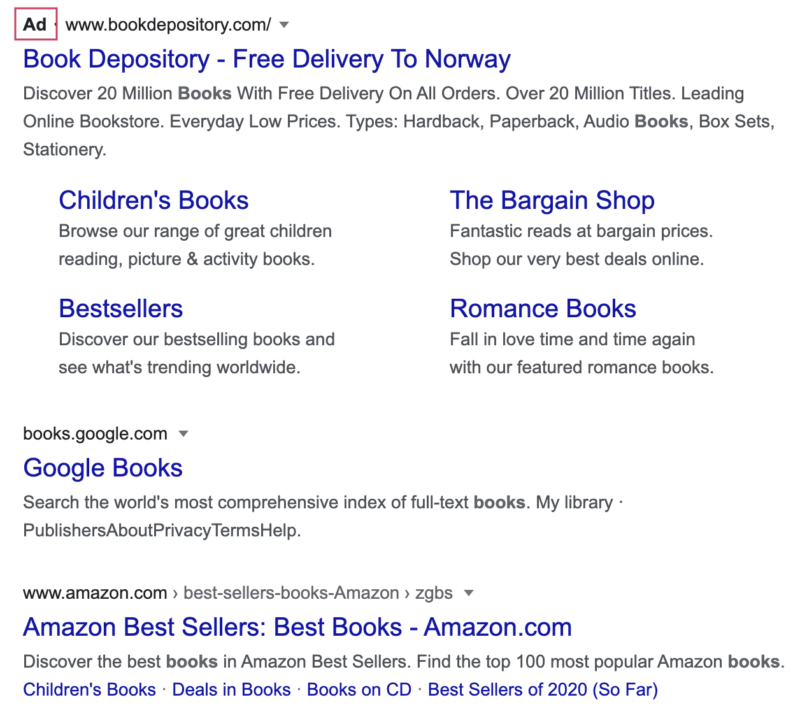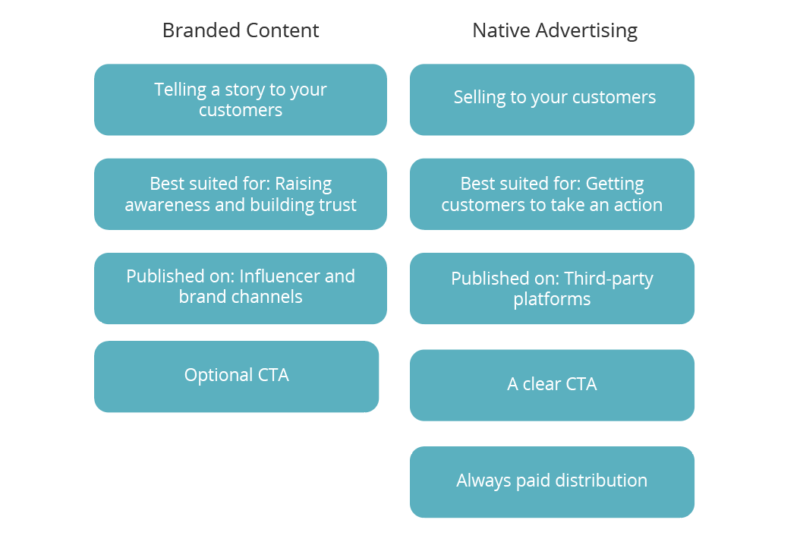It’s no secret that today’s consumers are deeply skeptical of traditional advertisements. The rise of ad blockers is driven by changing consumer perceptions and a growing intolerance for ads that are seen as obnoxious or misleading.
As a result, intrusive marketing techniques, like banner ads, are now less effective than before.
In this era of consumer mistrust, marketers have to take a subtler approach if they want to get their message across successfully. They need to look for new ways to connect with their target market – without being intrusive.
Branded content and native advertising are two ways to achieve this – but what’s the difference between them? When should brands utilize them?
Let’s find out by comparing branded content vs native advertising.
Table of Contents
Branded content vs native advertising: What are they?
To understand the difference, we’ll need to take a dive into what each of these terms mean.
Branded content
According to Instagram, branded content is “a creator or publisher’s content that features or is influenced by a business partner for an exchange of value.”
To simplify, branded content is content that influencers create to promote a brand. In return, the brand will compensate them with money and/or gifts.
Brands have traditionally worked with studios to create content for their marketing campaigns. But many have realized they can get high-quality content regularly from influencers too – at a fraction of the cost.
Some influencers are photographers, videographers, and graphic designers who are great at telling a story. They’re capable of producing content that you can reuse for billboards, social media, banner ads, print, and more!
The beauty of this marketing method is that influencers know their audience, so they know exactly what their followers want to see. This is how influencers have managed to build up a loyal following that engages with their content.
Having this skill means that branded content created by influencers often perform equally as well, or better, than studio-produced branded content.
Native advertising
Native advertising is a marketing technique where paid advertisements are placed on third-party platforms. These advertisements “match the form and function” of the platform where they appear.
In other words, native ads are paid ads, but they don’t look like ads.
The idea is that the customer looking at the ad will hardly notice that it’s an ad at all because it seamlessly blends into the surrounding content. It also provides the same kind of information the customer would expect to see on the website.
Note: It’s worth mentioning that there will always be some overlap between the two terms. For example, sponsored posts could be considered either native advertising or branded content, depending on the nature and positioning of the content.
An obvious example of native advertising is paid search units – the ad listings that appear at the top of the search results page. They look almost identical to the organic listings, except for the small, inconspicuous “ad” label on the top left.
However, this isn’t the only type of native advertising. There are actually 6 types of native ads worth knowing about, which are listed below.
The 6 types of native advertising
- In-feed units: Native ads that appear on social platforms and publishing websites as you scroll through the feed.
- Paid search units: Ads that appear at the top of search platforms like Yahoo, Google, or Bing.
- Recommendation widgets: Ads that appear at the side or bottom of articles. You often see them on news sites under a heading like “you may also like.”
- Promoted listings: Promoted products listed at the top of shopping websites, like Amazon or Etsy, above other organic listings.
- In-ad with native element units: Ad units that look like standard display ads, but contain contextually relevant content for the publisher. For example, an ad promoting a soft cheese brand that contained a recipe would be a native ad if it appeared on a recipe website.
- Custom: Any other kind of native ad that won’t fit into the above categories.
When should you use branded content?
Now you know the difference between the two techniques. The next question is: when does it make sense to use them as part of your marketing strategy?
Branded content is all about creating content to tell a story, entertain your audience, and tap into their emotions. So, it’s ideal for campaigns where the goal is to produce a lift in brand awareness, recognition, and engagement.
You can work with influencers to showcase your brand by telling a story that their followers connect with. By doing this, you’ll build trust and establish a relationship with them.
Branded content can also be a great way to generate leads and acquire new potential customers. For example, an influencer may produce a successful branded content video that goes viral. Viewers that enjoyed it might begin to follow you and engage with your brand, which can lead to more sales later down the line.
If your goal is to generate a short-term uplift in sales, it’s probably best devoting more of your marketing budget to other direct response marketing methods instead.
Qualities of branded content
Other qualities of branded content that make it a useful marketing technique include:
- Builds trust and authenticity: Influencers have a loyal following that trusts their recommendations. By working with them to create branded content, you’ll have a more authentic way of connecting with potential customers.
- Leverages storytelling: The main factor that distinguishes branded content from other marketing methods is that it’s all about telling a story. Storytelling helps humanize your brand and create an emotional connection with your audience.
- Appeals to the emotions: Branded content typically triggers an emotional response from an audience. This makes it more likely that they’ll remember and share the content.
- Come in multiple mediums: Branded content can come in many content forms. It might take the form of a podcast, video, photos, blog post, and more.
- Highlight brand values: A great thing about branded content is that it gives you an opportunity to highlight your brand values. We’ll take a look at how Dove did this successfully.
Example: Dove’s #ShowUs campaign
Dove gave us a masterclass on just how effective branded content can be with their #ShowUs campaign.
In their research, they discovered that 70% of women don’t feel represented in media & advertising. Dove decided to do something about it with their campaign.
They created the #ShowUs campaign to shatter beauty stereotypes and trigger social change.
To do this, they called for women from all walks of life, who feel different and proud, to share their images and stories using the #ShowUs hashtag. They gathered the images and partnered with Getty Images and Girl Gaze to build a stock photo library.
It currently contains 5,000 images, which media & advertising can freely use in their campaigns. By creating a library that showcases diversity and authenticity, Dove aims for every women to feel represented.
Not only does this kind of campaign tell a great, emotive story that is a recipe for viral success, it also aligns Dove with the kind of values that their consumers appreciate. This helps boost brand loyalty and trust. They show themselves as a beauty brand that celebrates real beauty and recognizes that all women are beautiful.
When should you use native advertising?
Unlike branded content, native advertising is more well-suited for lead generation and sales. It’s a more pushy marketing strategy that’s aimed at getting your customers to take action.
For example, brands might want to use in-feed or paid-search native advertising units to drive click traffic to an article, or use promoted listings to land more product sales.
Here are some of the main reasons brands might want to use native advertising:
- It attracts attention: According to data from Sharethrough, customers look at in-feed native ad units 25% more often than banner ads. They also look at native ads twice as often as editorial content – for the same amount of time.
- The potential distribution is greater: Native advertising allows for much greater content distribution than branded content. This enables you to reach a wider audience and get more eyes on your brand.
- There’s a higher click-through-rate (CTR): Unlike branded content, native ads typically contain a clear call to action which encourages users to click through. They have an average CTR that’s 8.8x higher than display ads.
- It’s less disruptive: Native ads are less disruptive to the user than traditional ads, as they don’t look like ads. They fit in with the surrounding website content, so they don’t negatively impact the user experience.
It’s important to mention that some critics point out that disguising ads as native content is misleading.
They argue native ads could be considered an unethical marketing practice because it’s hard to recognize the difference between unbiased editorial content and advertisements.
Everyone has a different opinion on this, so you’ll have to weigh up the pros and cons when using this tactic. They’re still definitely worth considering.
Why should you use both branded content and native advertising?
Struggling to know whether or not you should be focusing on branded content or native advertising? Here’s some good news – you don’t actually have to choose between them.
There’s a strong argument for including both in your marketing mix, as each strategy aligns to different marketing goals. Branded content can help you build trust with your audience. Native advertising can help you get them to take action.
Think carefully about what your main marketing goals are, and use this to determine which direction you want to take your campaign in.
Branded content vs native advertising at a glance
That’s a lot of information to digest!
Before we wrap up, here’s a quick summary of the key differences and benefits between branded content and native advertising that we’ve covered so far in a handy table.
Final thoughts
Alright, that about covers it the difference between branded content vs native advertising. We hope this article has given you some ideas of when you might want to use both tactics and how.
Questions? Just let us know in the comments!












